Are you a restaurant owner in Thailand looking to streamline your operations, improve customer satisfaction, and stay ahead of the competition? Or perhaps you’re simply curious about the latest trends in the Thai food service industry? If so, you’ve come to the right place. This comprehensive guide will explore everything you need to know about Self Ordering System in Thailand – ระบบสั่งออเดอร์สินค้าด้วยตนเองในประเทศไทย.
As we approach 2025, Thailand’s restaurant scene is revolutionizing itself with technology. The rise of self-ordering systems, or “ระบบสั่งออเดอร์สินค้าด้วยตนเองในประเทศไทย,” is transforming how restaurants operate and how customers experience dining. This article will delve into the benefits, challenges, and future of self-ordering systems in Thailand, providing you with actionable insights and practical solutions to help you make informed decisions.
What is a Self-Ordering System?
A self-ordering system allows customers to place their orders without direct interaction with a waiter or cashier. Customers can use touch screen kiosks, tablets, or even their own smartphones to browse the menu, customize their orders, and make payments.
Why are Self-Ordering Systems Thriving in Thailand?
Several factors contribute to the growing popularity of self-ordering systems in Thailand3:
- Efficiency and Convenience: In bustling urban centers like Bangkok, consumers value speed and convenience. Self-ordering systems offer a faster alternative to traditional ordering methods, reducing wait times.
- Tourism Industry Needs: Thailand’s tourism-dependent economy benefits from self-ordering systems that overcome language barriers and enhance the customer experience for international visitors.
- Shift in Consumer Preferences: The younger generation in Thailand is digitally savvy and embraces new technologies like self-ordering systems. Moreover, the COVID-19 pandemic has accelerated the adoption of contactless solutions.
Benefits of Self-Ordering Systems
Implementing a self-ordering system can bring numerous advantages to both restaurants and customers1:
- Enhanced Efficiency: Restaurants can process orders more quickly, allowing staff to focus on food preparation and customer service.
- Improved Accuracy: Self-ordering systems reduce errors as customers can review their orders before submitting them.
- Increased Sales: These systems can suggest additional items or special deals based on customers’ previous orders, boosting the average order value.
- Labor Cost Savings: By automating the ordering process, restaurants can optimize labor costs and allocate staff to other critical areas.
- Multilingual Support: Self-ordering systems can offer multiple language options, catering to both local and international customers.
- Seamless Payment Integration: These systems can accommodate various payment methods, including cash, e-wallets, and QR-based solutions like PromptPay.
- Better Customer Experience: Customers can browse menus at their leisure, customize their orders, and pay quickly and conveniently.
Real-World Examples in Thailand
Self-ordering systems are already making waves in various industries across Thailand3:
- Restaurants: International fast-food chains like McDonald’s and KFC have been pioneers in implementing self-ordering kiosks. Local restaurants are also adopting tablet-based systems for in-table ordering.
- Convenience Stores: Convenience store chains such as 7-Eleven are piloting self-checkout kiosks in select locations.
- Cinemas: Major cinema chains like Major Cineplex have introduced self-ordering kiosks for ticket purchases.
- Supermarkets: Large supermarket retailers like Tesco Lotus and Big C are implementing self-checkout systems.
- Black Canyon Coffee: This popular Thai coffee chain has partnered with KBTG to develop a self-ordering system that uses facial recognition to identify customers and recommend their favorite menu items.
Challenges to Overcome
Despite the numerous benefits, there are also challenges to consider when implementing a self-ordering system1:
- Initial Investment: The cost of installing kiosks or developing mobile applications can be a barrier for small restaurants.
- Digital Divide: Not everyone is comfortable using technology, and some customers may prefer the traditional ordering method.
- Maintenance and Technical Support: Restaurants need to ensure that the self-ordering systems are well-maintained and that technical support is readily available.
To address these challenges, restaurants can adopt a hybrid approach, offering both traditional and self-ordering options to cater to all customers1.
The Future of Self-Ordering Systems in Thailand
As technology continues to evolve, self-ordering systems in Thailand are expected to become even more advanced and integrated:
- Integration with AR and AI: Augmented reality (AR) and artificial intelligence (AI) can be incorporated into self-ordering systems to provide customers with 3D visualizations of their orders or AI-powered recommendations.
- Integration with Delivery Services: Self-ordering systems can be integrated with delivery services to streamline the ordering process and reduce waiting times.
- Expansion to Public Spaces: Self-ordering systems can be implemented in public areas, malls, and transportation hubs, creating a seamless and technologically advanced food ecosystem.
Actionable Steps for Implementing a Self-Ordering System
If you’re considering implementing a self-ordering system in your restaurant, here are some actionable steps to get you started:
- Assess Your Needs: Determine your specific goals and requirements for a self-ordering system. What problems are you trying to solve? What features are most important to your customers?
- Research Available Options: Explore the different types of self-ordering systems available, including kiosks, tablets, and mobile applications. Compare features, pricing, and customer support.
- Consider Integration: Think about how the self-ordering system will integrate with your existing point-of-sale (POS) system, inventory management system, and payment processing system.
- Choose a Vendor: Select a reputable vendor with experience in implementing self-ordering systems in Thailand. Look for a vendor that offers comprehensive training and ongoing support.
- Plan Your Implementation: Develop a detailed implementation plan that includes timelines, budgets, and resource allocation.
- Train Your Staff: Provide your staff with thorough training on how to use and maintain the self-ordering system.
- Promote Your New System: Let your customers know about your new self-ordering system through social media, email marketing, and in-store signage.
- Gather Feedback: Collect feedback from your customers on their experience with the self-ordering system. Use this feedback to make improvements and optimize the system.
By following these steps, you can successfully implement a self-ordering system that enhances your restaurant’s efficiency, improves customer satisfaction, and drives revenue growth.
Conclusion
Self-ordering systems are revolutionizing the dining sector in Thailand by easing workloads, optimizing customer experiences, and supporting the overall dine-out experience1. As Thailand advances, these systems are anticipated to become more advanced and a staple in diners’ lives, emphasizing speed, ease, and pleasure for both restaurateurs and customers1. By embracing and integrating this technology, Thailand’s food service industry is moving towards a future that emphasizes velocity, ease, and pleasure.
FAQs
Q: What is a self-ordering system?
Ans: A self-ordering system allows customers to place orders without direct interaction with staff, using kiosks, tablets, or smartphones.
Q: What are the benefits of using a self-ordering system?
Ans: Benefits include increased efficiency, improved accuracy, labor cost savings, multilingual support, and enhanced customer experience.
Q: Where are self-ordering systems commonly used in Thailand?
Ans: They are used in restaurants, convenience stores, cinemas, and supermarkets.
Q: What are some challenges of implementing self-ordering systems?
Ans: Challenges include initial investment costs and the digital divide among customers.
Q: How can restaurants overcome these challenges?
Ans: Restaurants can use a hybrid approach, offering both traditional and self-ordering options.
Q: What is the future of self-ordering systems in Thailand?
Ans: The future includes integration with AR and AI, delivery services, and expansion to public spaces.
Q: Are self-ordering kiosks safe to use during a pandemic?
Ans: Yes, they help to minimize contact, aligning with safety and sanitation needs.
Read More: Nasik Fatafat | Crypto 30x .com | 5StarsStocks.com Buy Now | Xalaflix EU | Make1m.com Millionaire | Catherine the Great Furniture


